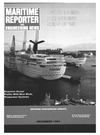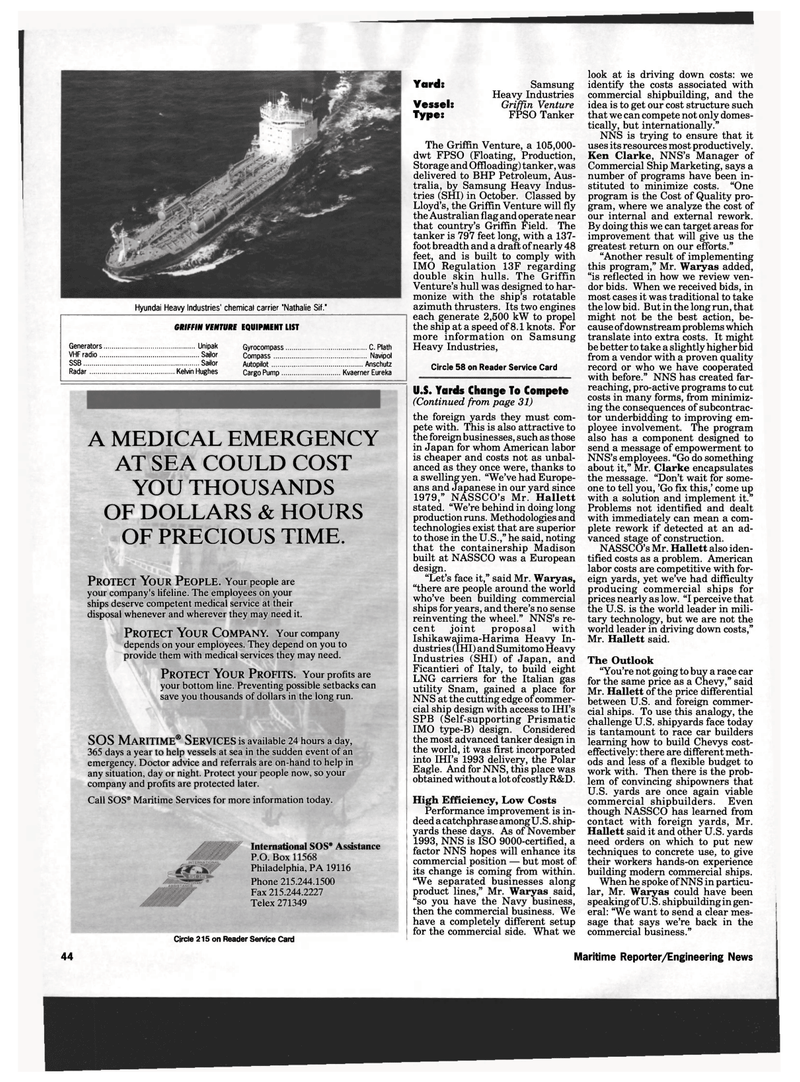
Page 42: of Maritime Reporter Magazine (December 1993)
Read this page in Pdf, Flash or Html5 edition of December 1993 Maritime Reporter Magazine
Hyundai Heavy Industries' chemical carrier "Nathalie Sif."
GRIFFIN VENTURE EQUIPMENT LIST
Generators Unipak
VHF radio Sailor
SSB Sailo
Radar Kelvin Hughes
Gyrocompass C. Plath
Compass Navipol
Autopilot Anschutz
Cargo Pump Kvaerner Eureka
A MEDICAL EMERGENCY
AT SEA COULD COST
YOU THOUSANDS
OF DOLLARS & HOURS
OF PRECIOUS TIME.
PROTECT YOUR PEOPLE. Your people are your company's lifeline. The employees on your ships deserve competent medical service at their disposal whenever and wherever they may need it.
PROTECT YOUR COMPANY Your company depends on your employees. They depend on you to provide them with medical services they may need.
PROTECT YOUR PROFITS. Your profits are your bottom line. Preventing possible setbacks can save you thousands of dollars in the long run.
SOS MARITIME® SERVICES is available 24 hours a day, 365 days a year to help vessels at sea in the sudden event of an emergency. Doctor advice and referrals are on-hand to help in any situation, day or night. Protect your people now, so your company and profits are protected later.
Call SOS® Maritime Services for more information today.
International SOS® Assistance
P.O. Box 11568
Philadelphia, PA 19116
Phone 215.244.1500
Fax 215.244.2227
Telex 271349
Circle 215 on Reader Service Card
Yard: Samsung
Heavy Industries
Vessel: Griffin Venture
Type: FPSO Tanker
The Griffin Venture, a 105,000- dwt FPSO (Floating, Production,
Storage and Offloading) tanker, was delivered to BHP Petroleum, Aus- tralia, by Samsung Heavy Indus- tries (SHI) in October. Classed by
Lloyd's, the Griffin Venture will fly the Australian flag and operate near that country's Griffin Field. The tanker is 797 feet long, with a 137- foot breadth and a draft of nearly 48 feet, and is built to comply with
IMO Regulation 13F regarding double skin hulls. The Griffin
Venture's hull was designed to har- monize with the ship's rotatable azimuth thrusters. Its two engines each generate 2,500 kW to propel the ship at a speed of 8.1 knots. For more information on Samsung
Heavy Industries,
Circle 58 on Reader Service Card
U.S. Yards Change To Compete (Continued from page 31) the foreign yards they must com- pete with. This is also attractive to the foreign businesses, such as those in Japan for whom American labor is cheaper and costs not as unbal- anced as they once were, thanks to a swelling yen. "We've had Europe- ans and Japanese in our yard since 1979," NASSCO's Mr. Hallett stated. "We're behind in doing long production runs. Methodologies and technologies exist that are superior to those in the U.S.," he said, noting that the containership Madison built at NASSCO was a European design. "Let's face it," said Mr. Waryas, "there are people around the world who've been building commercial ships for years, and there's no sense reinventing the wheel." NNS's re- cent joint proposal with
Ishikawajima-Harima Heavy In- dustries (IHI) and Sumitomo Heavy
Industries (SHI) of Japan, and
Ficantieri of Italy, to build eight
LNG carriers for the Italian gas utility Snam, gained a place for
NNS at the cutting edge of commer- cial ship design with access to IHI's
SPB (Self-supporting Prismatic
IMO type-B) design. Considered the most advanced tanker design in the world, it was first incorporated into IHI's 1993 delivery, the Polar
Eagle. And for NNS, this place was obtained without a lot of costly R&D.
High Efficiency, Low Costs
Performance improvement is in- deed a catchphrase amongU.S. ship- yards these days. As of November 1993, NNS is ISO 9000-certified, a factor NNS hopes will enhance its commercial position — but most of its change is coming from within. "We separated businesses along product lines," Mr. Waryas said, "so you have the Navy business, then the commercial business. We have a completely different setup for the commercial side. What we look at is driving down costs: we identify the costs associated with commercial shipbuilding, and the idea is to get our cost structure such that we can compete not only domes- tically, but internationally."
NNS is trying to ensure that it uses its resources most productively.
Ken Clarke, NNS's Manager of
Commercial Ship Marketing, says a number of programs have been in- stituted to minimize costs. "One program is the Cost of Quality pro- gram, where we analyze the cost of our internal and external rework.
By doing this we can target areas for improvement that will give us the greatest return on our efforts." "Another result of implementing this program," Mr. Waryas added, "is reflected in how we review ven- dor bids. When we received bids, in most cases it was traditional to take the low bid. But in the long run, that might not be the best action, be- cause of downstream problems which translate into extra costs. It might be better to take a slightly higher bid from a vendor with a proven quality record or who we have cooperated with before." NNS has created far- reaching, pro-active programs to cut costs in many forms, from minimiz- ing the consequences of subcontrac- tor underbidding to improving em- ployee involvement. The program also has a component designed to send a message of empowerment to
NNS's employees. "Go do something about it," Mr. Clarke encapsulates the message. "Don't wait for some- one to tell you, 'Go fix this,' come up with a solution and implement it."
Problems not identified and dealt with immediately can mean a com- plete rework if detected at an ad- vanced stage of construction.
NASSCO's Mr. Hallett also iden- tified costs as a problem. American labor costs are competitive with for- eign yards, yet we've had difficulty producing commercial ships for prices nearly as low. "I perceive that the U.S. is the world leader in mili- tary technology, but we are not the world leader in driving down costs,"
Mr. Hallett said.
The Outlook 'You're not going to buy a race car for the same price as a Chevy," said
Mr. Hallett of the price differential between U.S. and foreign commer- cial ships. To use this analogy, the challenge U.S. shipyards face today is tantamount to race car builders learning how to build Chevys cost- effectively: there are different meth- ods and less of a flexible budget to work with. Then there is the prob- lem of convincing shipowners that
U.S. yards are once again viable commercial shipbuilders. Even though NASSCO has learned from contact with foreign yards, Mr.
Hallett said it and other U.S. yards need orders on which to put new techniques to concrete use, to give their workers hands-on experience building modern commercial ships.
When he spoke of NNS in particu- lar, Mr. Waryas could have been speaking of U.S. shipbuilding in gen- eral: "We want to send a clear mes- sage that says we're back in the commercial business." 44 Maritime Reporter/Engineering News

 41
41

 43
43
